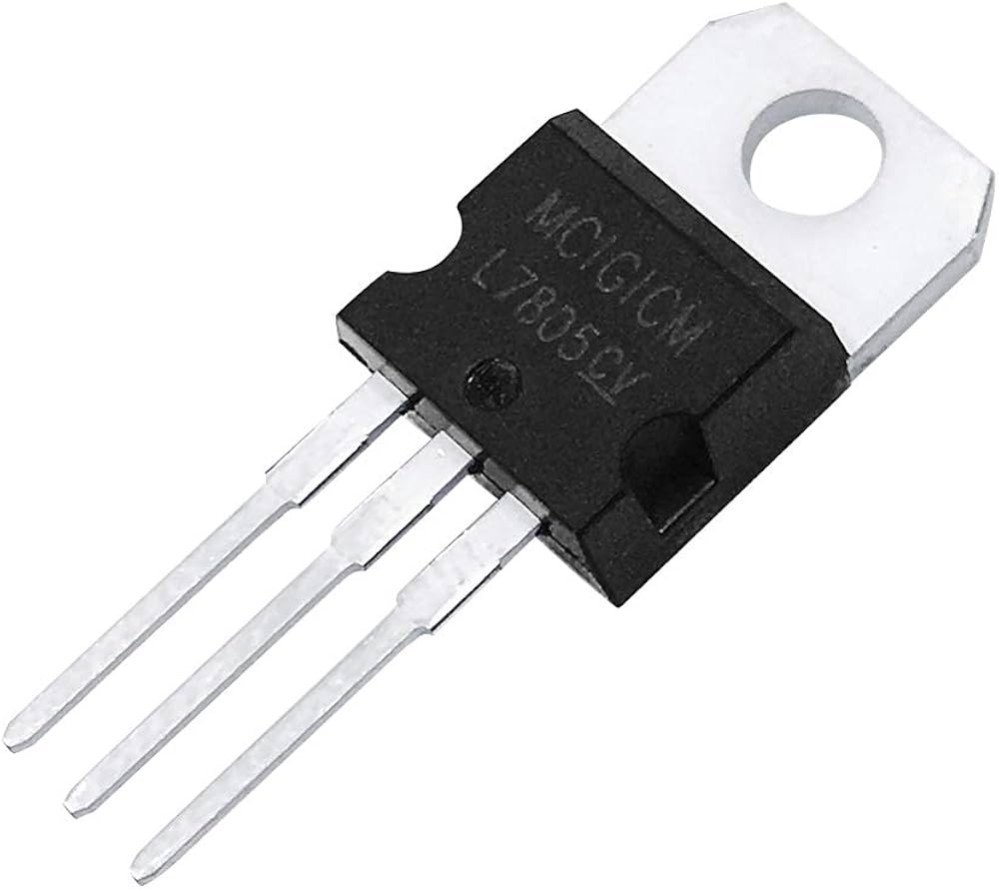





7805 VOLTAGE REGULATOR
The 7805 voltage regulator is a widely used linear voltage regulator that provides a stable +5V output from a higher input voltage. It is part of the 7800 series of voltage regulators, which are designed to provide a fixed output voltage at a relatively constant value despite fluctuations in the input voltage.
₹ 11 ₹29
29



| Made In : | India |
Add FAQ
The 7805 voltage regulator is a widely used linear voltage regulator that provides a stable +5V output from a higher input voltage. It is part of the 7800 series of voltage regulators, which are designed to provide a fixed output voltage at a relatively constant value despite fluctuations in the input voltage.
Key Features of the 7805 Voltage Regulator:
- Output Voltage: The 7805 provides a fixed 5V output (±2% tolerance).
- Input Voltage: Typically, the input voltage to the 7805 should be higher than 5V. The minimum input voltage is around 7V (recommended 9V to 12V) for stable operation, but it can go up to 35V.
- Current Rating: The 7805 can supply a maximum output current of 1A (depending on the heat dissipation and the input voltage).
- Thermal Overload Protection: Built-in thermal protection limits the maximum operating temperature to prevent overheating.
- Short Circuit Protection: It has internal short circuit protection, which makes it safe in case of load shorting.
- Low Dropout Voltage: The voltage drop across the regulator (the difference between input and output voltages) is typically around 2V at higher currents, meaning the input voltage should be at least 7V for proper regulation.
- Package Types: Common packages include TO-220 (for through-hole) and TO-263 (for surface-mount).
Pin Configuration (TO-220 Package):
- Pin 1 (Input): This is where the unregulated voltage is supplied (typically 9V to 35V).
- Pin 2 (Ground): This pin is connected to the common ground of the circuit.
- Pin 3 (Output): This is the regulated 5V output.
Applications of the 7805 Voltage Regulator:
-
Power Supply for Electronics:
- The most common use of the 7805 is to power 5V logic circuits, microcontrollers (like Arduino or Raspberry Pi), or other low-voltage devices from a higher voltage source (e.g., 12V or 9V batteries).
-
Battery-Powered Circuits:
- It is widely used in battery-powered applications where a regulated 5V is required. The 7805 can take an unregulated battery voltage and reduce it to a stable 5V output to power sensors, ICs, or small modules.
-
Arduino and Microcontroller Projects:
- Many Arduino and Raspberry Pi projects use a 7805 voltage regulator to ensure the 5V power supply for the board and peripherals.
-
Powering Low-Power Devices:
- The 7805 is also used to provide power to low-power communication devices, sensors, or small LEDs that require a stable 5V supply.
-
Power Supply for Audio Systems:
- Some audio systems, especially low-power applications like headphone amplifiers, use a 7805 to provide the regulated 5V required for operation.
Example Circuit for Using a 7805:
Here’s a simple example of how to use the 7805 voltage regulator in a circuit to power a 5V device (such as a microcontroller) from a 12V source:
Components:
- 7805 Voltage Regulator
- Capacitors (optional but recommended):
- Input capacitor: Typically a 0.33µF capacitor on the input to reduce noise.
- Output capacitor: Typically a 0.1µF capacitor on the output to improve transient response and stability.
Circuit:
- Connect the Input Pin (Pin 1) of the 7805 to the +12V supply.
- Connect the Ground Pin (Pin 2) of the 7805 to the common ground.
- Connect the Output Pin (Pin 3) to the 5V line, which powers your device (e.g., a microcontroller, LED, etc.).
- Optionally, place a 0.33µF capacitor between the Input Pin (Pin 1) and Ground (Pin 2) to filter noise from the input.
- Optionally, place a 0.1µF capacitor between the Output Pin (Pin 3) and Ground (Pin 2) for stability.
Diagram:
+12V
|
[7805]
| |
0.33µF| |0.1µF
| |
GND ---- GND
|
+5V Output (for your device)
Important Notes:
-
Heat Dissipation: The 7805 is a linear regulator, meaning it dissipates excess energy as heat. If the voltage difference between input and output is high (e.g., 12V to 5V), the regulator will get hot, especially if it’s supplying significant current. Heatsinks or adequate ventilation may be needed to prevent overheating.
-
Efficiency: Linear regulators like the 7805 are not very efficient, especially when there’s a large voltage difference between input and output. For instance, if you input 12V and get 5V out, the regulator wastes a lot of energy as heat. For better efficiency, switching regulators (buck converters) are preferred, especially when the input voltage is much higher than the output voltage.
-
Capacitors: While capacitors are optional, they help improve the performance of the 7805, especially in noisy environments, where the regulator might otherwise become unstable or generate noise.
Advantages of the 7805:
- Simple to use: The 7805 is very easy to implement in circuits and requires only a few passive components.
- Reliable: It has built-in protection features such as thermal and short-circuit protection.
- Low Cost: The 7805 is inexpensive and readily available.
- Versatile: It works well in a wide range of applications that require a stable 5V power supply.
Conclusion:
The 7805 voltage regulator is an excellent choice for providing a stable 5V output from a higher voltage source. It is widely used in microcontroller projects, battery-powered circuits, and power supply systems where low power consumption and simplicity are key. However, due to its linear nature, care should be taken with heat dissipation in high-power applications, and for higher efficiency, a switching regulator may be more suitable.

0 Reviews For this Product









2.jpeg&width=225&quality=80)
2.jpeg&width=225&quality=80)
.jpeg&width=225&quality=80)

